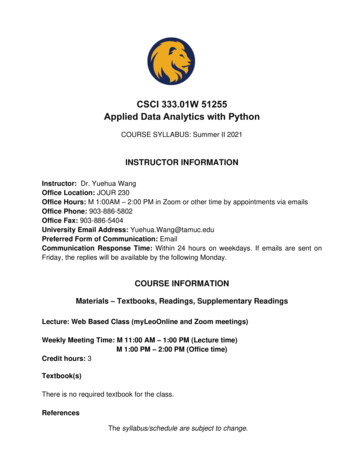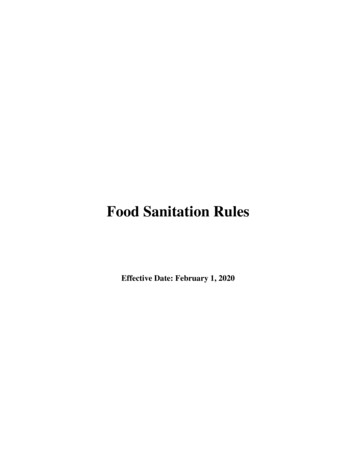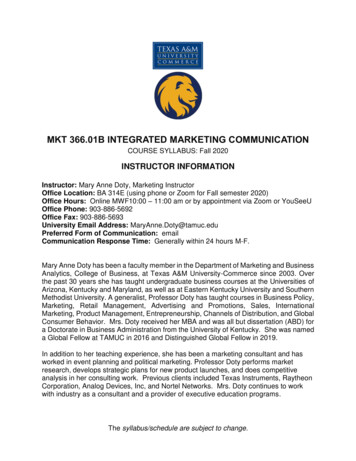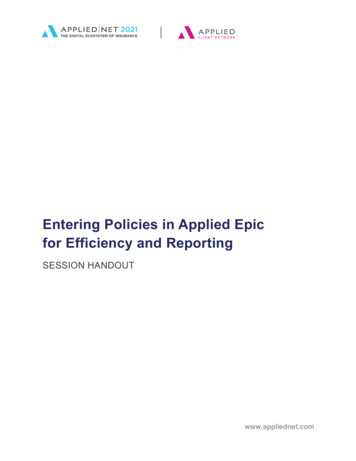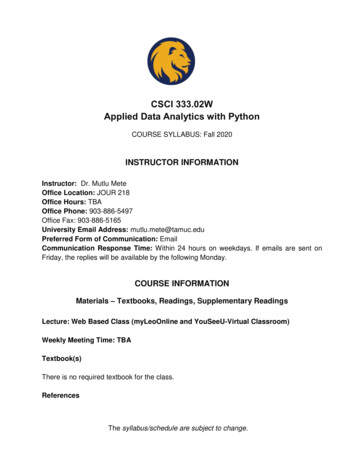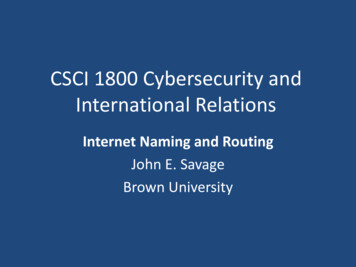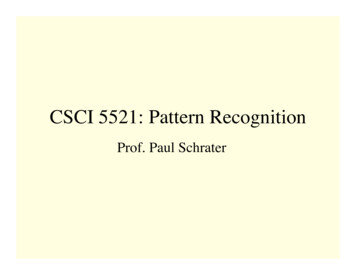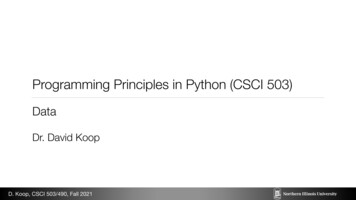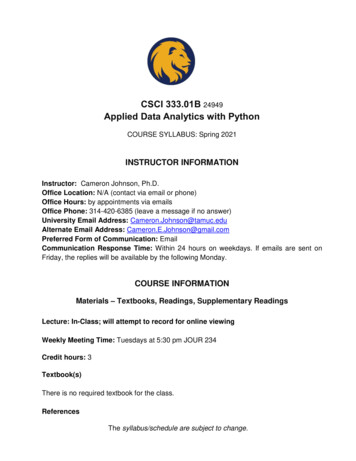
Transcription
CSCI 333.01B 24949Applied Data Analytics with PythonCOURSE SYLLABUS: Spring 2021INSTRUCTOR INFORMATIONInstructor: Cameron Johnson, Ph.D.Office Location: N/A (contact via email or phone)Office Hours: by appointments via emailsOffice Phone: 314-420-6385 (leave a message if no answer)University Email Address: Cameron.Johnson@tamuc.eduAlternate Email Address: Cameron.E.Johnson@gmail.comPreferred Form of Communication: EmailCommunication Response Time: Within 24 hours on weekdays. If emails are sent onFriday, the replies will be available by the following Monday.COURSE INFORMATIONMaterials – Textbooks, Readings, Supplementary ReadingsLecture: In-Class; will attempt to record for online viewingWeekly Meeting Time: Tuesdays at 5:30 pm JOUR 234Credit hours: 3Textbook(s)There is no required textbook for the class.ReferencesThe syllabus/schedule are subject to change.
In most cases, the instructor’s slides are sufficient for understanding all topics covered bythis course. The following books and websites may be useful as references or tutorials forPython studying.Books: Python Crash Course, 2nd Edition: A Hands-On, Project-Based Introduction toProgramming by Eric MatthesISBN-10: 1593279280 ISBN-13: 978-1593279288 Intro to Python for Computer Science and Data Science: Learning to Program withAI, Big Data and The Cloud by Paul J. Deitel , and Harvey DeitelISBN-13: 978-0135404676 ISBN-10: 0135404673 Practice of Computing Using Python, The, Student Value Edition,3rd Edition,by William F. Punch, and Richard EnbodyISBN-13: 978-0134380315 ISBN-10: 0134380312 Python for Everyone, 2nd Edition by Cay S. Horstmann, Rance D. NecaiseISBN-13: 978-1119056553 ISBN-10: 1119056551 Python for Data Analysis: Data Wrangling with Pandas, NumPy, and IPython 2ndEditionby Wes McKinneyISBN-13: 978-1491957660 ISBN-10: 1491957662 Python for Software Design: How to Think Like a Computer Scientist 1st Editionby Allen B. Downey (Author). Available thon.htmlISBN-13: 978-0521725965 ISBN-10: 0521725968 Automate the Boring Stuff with Python: Practical programming for total beginners byAl Sweigart. Available at https://automatetheboringstuff.com/ISBN-10: 1593275994 ISBN-13: 978-1593275990Websites: Anaconda download and tutorials: https://www.anaconda.com/ Python for beginners: https://www.python.org/about/gettingstarted/ Jython: https://www.jython.org/ Learnpython: https://www.learnpython.org/ Google’s Python Class: https://developers.google.com/edu/python/ The Python Tutorial: https://docs.python.org/3/tutorial/ Tutorialpoint: tware RequiredThe syllabus/schedule are subject to change.
Students may develop your programs on any machine that you like: we encourage you touse your own equipment. We provide instructions for setting up a Python programmingenvironment under Windows, OS X, and Linux.You can use one of the several excellent Python IDEs available, with instructor materialsfocusing on Anaconda, which is freely available for academic use and works on the majorcomputing platforms (Windows, OS X, and Linux)Course DescriptionThis course covers both theoretical and practical aspects of applied data science, analytics,and visualization in Python. We will start from general python programming basics, datastructures, and algorithm design with a heavy emphasis on applying data analysis andvisualization techniques to solve real-world problems in different domains. Topics includedata representation, manipulation and clearing, visualization, regression, convolutional andrecurrent neural networks, reinforcement learning, model development and evaluation withmost up-to-date Python modules and popular toolkits.Prerequisites: COSC 2336Supplementary information for the course is available at D2L. Log on with your Access IDfor class notes, lecture slides, class announcements, the course syllabus, and otherinformation for the course. You will submit your assignments and project and check gradesthere too.Student Learning Outcomes (Should be measurable; observable; use action verbs)This course will focus heavily on hands-on work and practical skills. You learn new conceptsand techniques, and then, exercise these new-found skills. At the end of the class, studentscan1) (SLO333.1) Self configure various Python programming environment.2) (SLO333.2) Code, compile, debug, and run Python programs3) (SLO333.3) Learn Python language syntax and fundamental programmingconcepts including variables, control statements, loops, functions, lists, and classes4) (SLO333.4) Use modules and tools to collect, reshape, analysis, and visualize data5) (SLO333.5) Develop programs for various real-world problems by applying datascience6) (SLO333.6) Evaluate data results and make optimal decisionsThe syllabus/schedule are subject to change.
COURSE REQUIREMENTSMinimal Technical Skills NeededUsing computers, operating systems, program compilers, IDE, and Microsoft WordInstructional MethodsThis course is lecture supplemented by text and D2L. To get started with the course, go to:https://leo.tamuc.edu. You will need your CWID and password to log in to the course.Student Responsibilities or Tips for Success in the Course1. Make-up examinations for exams will not be given with valid documents. If you havea compelling and documented reason for not being able to attend the exam, you mustmake the alternative arrangements before the examination. Grades will not be curvedfor the course, and you will receive the grade that you earn through your performanceon the assignments, exams, project, and bonus questions. There will be no individualexceptions to the grading policy, and, therefore grades of a C or F are possible.2. No late work will be accepted except under special extenuating circumstanceswhen prior arrangements have been made with the instructor.3. Grades will be posted within one week after assignment due date.4. You are responsible to check your grades after each assignment. Please reportany error or inconsistency to the instructor within 7 days if possible.5. All assignments must be submitted using D2L if applicable. Students must adhere tothe following rules when submitting assignments. Failure to do so will affect theirgrades. File NameShould be named according to the following pattern: LastFirstX.**, where Lastis the student’s last name, First is the student’s first name, and X is the assignmentnumber. For example, student John White would submit WhiteJohn3.py forprogramming assignment 3. File Header The first lines of the submitted file should include a comment with thefollowing information and format:# Program Name# A short description of the program.#The syllabus/schedule are subject to change.
# @author Last Name, First Name# @assignment CSCI 333 Assignment X# @dateDate#6. All students are requested to access their university e-mail account regularly. Youmay be contacted when important matters arise. If you have any questions aboutthe course or need assistance, please contact the instructor and/or the TA inperson during office hours or by e-mail at any time.GRADINGLetter grades for the course will be assigned according to this scale of the percentagesgiven below.ABCDF90% -100%80% - 89%70% - 79%60% - 69%59% or BelowAssessmentsEnd-of-semester numeric scores will be weighted as follows. Assignments/LabsExam 01Exam 02ProjectQuiz45%15%15%20%5%Notes:A. Assignments/Labs:Each week there would be an assignment and/or lab that should be solvedindependently and tightly related to the class materials and topics. Submissions arealways expected to be finished in a good shape by deadlines. All assignment mustbe formally submitted to the assignment folder. Email or any other formats ofsubmissions do not count and will not be graded. If you have difficulty accessing D2Ltemporarily, you can email me your assignment as a proof of on-time submission.The syllabus/schedule are subject to change.
However, you still need to upload it to the assignment folder as soon the issue isresolved to receive credit.Neither late assignments nor labs would be allowed without instructor’s permission.The instructor should be prior notified with adequate verifiable documentation (e.g.,medical letters or police reports). For the documentation, it will depend on the type ofproblems that you have experienced. The department and instructor reserve the rightto check on the validity of the documents you submit and reject your requests/claimsdue to the lack of the evidence. Without any valid documentary evidence, a 10% perday late penalty would be applied to submissions including assignments and labs.Submissions will NOT be accepted or even considered more than 4 days after thedue date. If it is the case, a grade of zero will be awarded to the submission or missedwork.B. AttendanceStudents should attend the lecture in person if possible. Due to the coronavirus, effortwill be made to have class available remotely or recorded; students who cannot bethere in person should either participate live remotely, or listen to the recordedlecture. Students are required to keep up with class materials and announcementmade during live lectures or via emails, including changes to due dates orassignments. Attendance will be evaluated based on the submission of assignmentsand labs.C. Quizzes and ExamsYou should do your own work on exams, assignments and labs. Copying anotherstudent’s work is not acceptable. Any indication of cheating or plagiarism on anexam/assignment will result in an automatic 0 (zero) for the exam/assignment for allstudents involved. In addition, cheating or plagiarism in any aspect of the class isgrounds for an F grade for the students involved. Students may be required to explainthe code they submit, and inability to explain it adequately can result in a reducedgrade or a 0.Quizzes and exams are graded based on the correctness of the answers. Quizzesare unannounced pop-up quizzes. The time of each quiz will be announced at thebeginning of the class. Quizzes will be on D2L, and generally due by midnightfollowing the class in which they are assigned. All exams are comprehensive. Thetime and location of each exam will be announced one week before the exam. Allstudents are expected to be present for exams. The instructor should be notified inThe syllabus/schedule are subject to change.
advance in the event that students will be absent with adequate verifiabledocumentation (e.g., medical letters or police reports). Failure to do so may result inthe student receiving zero for the missed exam.D. Final projectThe final project consists of problems, solutions, source code, and a project report.More details are provided in the final project guideline.E. Bonus creditAccording to the quality, completion, and/or creativity of assignments, labs, andexams, students may be awarded bonus credit in some cases.Additional notes:You must earn an A on your own. Assume that you have completed all assignments, lowerborderline grades may be affected positively or negatively by factors such as: the class grade distributionyour class attendance, participation, and behavior (including what should becommon courtesies: no sound-producing device use in class, arrive on time, stayuntil class is over, avoid distracting other students)You need to give me a reason to think you deserve a grade higher than your percentageindicates and that you’ve made every effort to help yourself (you’re attending class, are atleast attempting programs, and participating in the current events discussions).This class makes use of D2L for information and resource sharing. Assignments will beuploaded to D2L course shell. Students are responsible for obtaining and setting up theirD2L account using their TAMUC student login. They need to follow the D2L course shelldaily for the course announcements, downloading and uploading the assignments, andother course activities.TECHNOLOGY REQUIREMENTSBrowser supportD2L is committed to performing key application testing when new browser versions arereleased. New and updated functionality is also tested against the latest version ofThe syllabus/schedule are subject to change.
supported browsers. However, due to the frequency of some browser releases, D2Lcannot guarantee that each browser version will perform as expected. If you encounterany issues with any of the browser versions listed in the tables below, contact D2LSupport, who will determine the best course of action for resolution. Reported issues areprioritized by supported browsers and then maintenance browsers.Supported browsers are the latest or most recent browser versions that are tested againstnew versions of D2L products. Customers can report problems and receive support forissues. For an optimal experience, D2L recommends using supported browsers with D2Lproducts.Maintenance browsers are older browser versions that are not tested extensively againstnew versions of D2L products. Customers can still report problems and receive support forcritical issues; however, D2L does not guarantee all issues will be addressed. Amaintenance browser becomes officially unsupported after one year.Note the following: Ensure that your browser has JavaScript and Cookies enabled.For desktop systems, you must have Adobe Flash Player 10.1 or greater.The Brightspace Support features are now optimized for production environmentswhen using the Google Chrome browser, Apple Safari browser, MicrosoftEdge browser, Microsoft Internet Explorer browser, and Mozilla Firefox browsers.Desktop SupportBrowserSupported Browser Version(s) Maintenance Browser Version(s)Microsoft EdgeLatestN/AMicrosoft InternetExplorer N/A11Mozilla Firefox Latest, ESRN/AGoogle Chrome LatestN/AApple Safari LatestN/ATablet and Mobile SupportDeviceAndroid Operating SystemAndroid 4.4 BrowserChromeSupported Browser Version(s)LatestThe syllabus/schedule are subject to change.
DeviceAppleOperating SystemiOS BrowserSafari,ChromeSupported Browser Version(s)The current major version of iOS(the latest minor or point release ofthat major version) and the previousmajor version of iOS (the latestminor or point release of that majorversion). For example, as of June 7,2017, D2Lsupports iOS 10.3.2 andiOS 9.3.5, but not iOS 10.2.1, 9.0.2,or any other version.Chrome: Latest version for theiOS browser.WindowsWindows 10Edge,Chrome,FirefoxLatest of all browsers, and FirefoxESR. You will need regular access to a computer with a broadband Internet connection. Theminimum computer requirements are:o 512 MB of RAM, 1 GB or more preferredo Broadband connection required courses are heavily video intensiveo Video display capable of high-color 16-bit display 1024 x 768 or higherresolution You must have a:o Sound card, which is usually integrated into your desktop or laptop computero Speakers or headphones.o *For courses utilizing video-conferencing tools and/or an online proctoringsolution, a webcam and microphone are required. Both versions of Java (32 bit and 64 bit) must be installed and up to date on yourmachine. At a minimum Java 7, update 51, is required to support the learningmanagement system. The most current version of Java can be downloaded at: JAVAweb site http://www.java.com/en/download/manual.jsp Current anti-virus software must be installed and kept up to date.Running the browser check will ensure your internet browser is supported.Pop-ups are allowed.JavaScript is enabled.The syllabus/schedule are subject to change.
Cookies are enabled. You will need some additional free software (plug-ins) for enhanced web browsing.Ensure that you download the free versions of the following software:o Adobe Reader https://get.adobe.com/reader/o Adobe Flash Player (version 17 or later) https://get.adobe.com/flashplayer/o Adobe Shockwave Player https://get.adobe.com/shockwave/o Apple Quick Time http://www.apple.com/quicktime/download/ At a minimum, you must have Microsoft Office 2013, 2010, 2007 or Open Office.Microsoft Office is the standard office productivity software utilized by faculty, students,and staff. Microsoft Word is the standard word processing software, Microsoft Excel isthe standard spreadsheet software, and Microsoft PowerPoint is the standardpresentation software. Copying and pasting, along with attaching/uploading documentsfor assignment submission, will also be required. If you do not have Microsoft Office, youcan check with the bookstore to see if they have any student copies.LMSAll course sections offered by Texas A&M University-Commerce have a correspondingcourse shell in the myLeo Online Learning Management System (LMS). Below aretechnical requirementsLMS rticle/Brightspace-Platform-RequirementsLMS Browser rightspace/requirements/all/browser support.htmYouSeeU Virtual Classroom ESS AND NAVIGATIONYou will need your campus-wide ID (CWID) and password to log into the course. If you donot know your CWID or have forgotten your password, contact the Center for IT Excellence(CITE) at 903.468.6000 or helpdesk@tamuc.edu.The syllabus/schedule are subject to change.
Note: Personal computer and internet connection problems do not excuse the requirementto complete all course work in a timely and satisfactory manner. Each student needs to havea backup method to deal with these inevitable problems. These methods might include theavailability of a backup PC at home or work, the temporary use of a computer at a friend'shome, the local library, office service companies, Starbucks, a TAMUC campus opencomputer lab, etc.COMMUNICATION AND SUPPORTBrightspace SupportNeed Help?Student SupportIf you have any questions or are having difficulties with the course material, please contactyour Instructor.Technical SupportIf you are having technical difficulty with any part of Brightspace, pleasecontact Brightspace Technical Support at 1-877-325-7778. Other support options canbe found ontactsupport.System MaintenanceD2L runs monthly updates during the last week of the month, usually on Wednesday.The system should remain up during this time unless otherwise specified in anannouncement. You may experience minimal impacts to performance and/or look andfeel of the environment.Interaction with Instructor StatementInteraction with Instructor Statement: For general questions and assistance with the course,the instructor will keep a schedule of 6 regular office hours per week. If a student cannotmeet during the designated schedule, arrangements can be made to meet at a moreconvenient time. An email should be sent to the instructor at least 24 hours prior to the timethe student plans on meeting. Generally, I will reply to your e-mail messages in a timelymanner. A reply can be expected within 24 hours.My responsibilities:The syllabus/schedule are subject to change.
1) Make sure to accommodate all your learning needs2) Try my best to answer your questions and resolve other related issues3) Give feedback and your grade on assignments within one week of the due date.COURSE AND UNIVERSITY PROCEDURES/POLICIESCourse Specific Procedures/PoliciesClass Decorum Civility in the classroom or online course and respect for the opinions ofother is very important in an academic environment. It is likely you may not agree witheverything that is said or discussed in the classroom/online course. Courteous behavior andresponses are expected. To create and preserve a learning environment that optimizesteaching and learning, all participants share a responsibility in creating a civil and nondisruptive forum. Students are expected to conduct themselves at all times in a manner thatdoes not disrupt teaching or learning. Faculty have the authority to request students whoexhibit inappropriate behavior to leave the class/online course and may refer seriousoffenses to the University Police Department and/or the Dean of Students for disciplinaryaction. (See Student Guidebook)Academic HonestyIt is the policy of the University, the History Department, and the instructor that no form ofplagiarism or cheating will be tolerated. Plagiarism is defined as the deliberate use ofanother’s work and claiming it as one’s own. This means ideas as well as text, whetherparaphrased or presented verbatim (word-for-word). Cheating is defined as obtainingunauthorized assistance on any assignment. Collusion is defined as selling or purchasingacademic products with the intention that they be submitted to fulfill an academic or courserequirement. Proper citation of sources must always be utilized thoroughly and accurately.Cheating/plagiarism/collusion will result in a grade of “0” for the assignment, and may alsoresult in failure of the course and/or disciplinary action by the University. Any student foundguilty of violating academic integrity policy will fail the assignment in question, willautomatically fail the course and will be subject to disciplinary action by the university (seeTexas A&M University-Commerce Code of Student Conduct 5.b. [1,2,3]). Furtherinformation on the history department’s plagiarism policy can be found on the departmentwebpage. If you are unclear about what constitutes academic dishonesty, ask.Writing CenterStudents are encouraged to take advantage of the Writing Center’s resources for assistancewith drafting their written assignments. Although the center will not write your paper for you,it may help you to improve your writing skills. If you use the Writing Center, plan in advancebecause it can only help you if there is adequate time to incorporate their suggestions intoThe syllabus/schedule are subject to change.
your paper. Additionally, I am willing to read rough drafts (and even multiple drafts) of yourwritten work so long as the drafts are submitted at least one week prior to the due date.Syllabus Change PolicyThe syllabus is a guide. Circumstances and events, such as student progress, may makeit necessary for the instructor to modify the syllabus during the semester. Any changesmade to the syllabus will be announced in advance.University Specific ProceduresStudent ConductAll students enrolled at the University shall follow the tenets of common decency andacceptable behavior conducive to a positive learning environment. The Code of StudentConduct is described in detail in the Student tudents should also consult the Rules of Netiquette for more information regarding howto interact with students in an online forum: es.htmlTAMUC AttendanceFor more information about the attendance policy please visit the Attendance webpage andProcedure 99.R0.01.pdfAcademic IntegrityStudents at Texas A&M University-Commerce are expected to maintain high standards ofintegrity and honesty in all of their scholastic work. For more details and the definition ofacademic dishonesty see the following procedures:Undergraduate Academic Dishonesty AcademicDishonesty.pdfGraduate Student Academic Dishonesty 13.99.99.R0.10The syllabus/schedule are subject to change.
.pdfStudents with Disabilities-- ADA StatementThe Americans with Disabilities Act (ADA) is a federal anti-discrimination statute thatprovides comprehensive civil rights protection for persons with disabilities. Among otherthings, this legislation requires that all students with disabilities be guaranteed a learningenvironment that provides for reasonable accommodation of their disabilities. If you have adisability requiring an accommodation, please contact:Office of Student Disability Resources and ServicesTexas A&M University-CommerceGee Library- Room 162Phone (903) 886-5150 or (903) 886-5835Fax (903) 468-8148Email: studentdisabilityservices@tamuc.eduWebsite: Office of Student Disability Resources and rimination NoticeTexas A&M University-Commerce will comply in the classroom, and in online courses, withall federal and state laws prohibiting discrimination and related retaliation on the basis ofrace, color, religion, sex, national origin, disability, age, genetic information or veteranstatus. Further, an environment free from discrimination on the basis of sexual orientation,gender identity, or gender expression will be maintained.Campus Concealed Carry StatementTexas Senate Bill - 11 (Government Code 411.2031, et al.) authorizes the carrying of aconcealed handgun in Texas A&M University-Commerce buildings only by persons whohave been issued and are in possession of a Texas License to Carry a Handgun. Qualifiedlaw enforcement officers or those who are otherwise authorized to carry a concealedhandgun in the State of Texas are also permitted to do so. Pursuant to Penal Code (PC)46.035 and A&M-Commerce Rule 34.06.02.R1, license holders may not carry a concealedhandgun in restricted locations.For a list of locations, please refer to the Carrying Concealed Handguns On CampusThe syllabus/schedule are subject to change.
document and/or consult your event organizer.Web loyeesAndStudents/34.06.02.R1.pdfPursuant to PC 46.035, the open carrying of handguns is prohibited on all A&M-Commercecampuses. Report violations to the University Police Department at 903-886-5868 or 9-1-1.COURSE OUTLINE / CALENDARMeets 12 Jan 2021 through 7 May 2021: Week 1 : Course Introduction, overview of Python, basic elements of Python, andfirst Python programWeek 2 : Fundamental programming concepts I: including Syntax and semantics,variables, expressions, assignments, selections, and loopsWeek 3 : Fundamental programming concepts IIWeek 4 : Functions and fundamental data structures IWeek 5 : Functions and fundamental data structures IIWeek 6 : File IO and exception handlingWeek 7 : Algorithms and recursionWeek 8 : Midterm examWeek 9: Python libraries and Data collectionWeek 10: Mathematical and scientific computingWeek 11: Data manipulation and visualizationWeek 12: Machine learning IWeek 13: Machine learning IIWeek 14: Example project study and analysis IWeek 15: Example project study and analysis IIFinal Week: Final ExamNote: The right to modify the presentation order of materials is reserved. Courseprogress will be based on feedback and suggestion from students. We would cover thecourse materials, so if we slow in some topics, we must accelerate elsewhere.HAVE A HAPPY AND SUCCESSFUL SEMESTERThe syllabus/schedule are subject to change.
The syllabus/schedule are subject to change. CSCI 333.01B 24949 Applied Data Analytics with Python COURSE SYLLABUS: Spring 2021 INSTRUCTOR INFORMATION Instructor: Cameron Johnson, Ph.D. Office Location: N/A (contact via email or phone) Office Hours: by appointments via emails Office Phone: 314-420-6385 (leave a message if no answer) University Email Address: Cameron.Johnson@tamuc.edu
